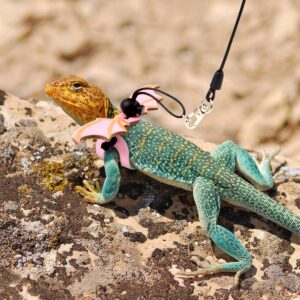Have you ever imagined taking your bearded dragon for a stroll outdoors, but worried about their safety and comfort? Your lasting solution is the bearded dragon harness with wings. This innovative accessory combines practicality with style, allowing you to securely leash your reptilian companion while giving them the freedom to spread their wings.
Whether it’s for a leisurely walk in the park or a bonding adventure in your backyard, this harness offers both you and your bearded dragon a unique experience like no other. Let’s delve into the world of bearded dragon harnesses with wings and discover how they’re revolutionizing the way we interact with our scaly friends.
Top 5 Bearded dragon harness with wings
1. WATFOON Adjustable Lizard Leash Bearded Dragon Harness
2. Bearded Dragon Carrier and Leash Harness with Wings
3. BWOGUE Bearded Dragon Harness and Leash Adjustable Leather Lizard Reptiles Harness
4. ADOGGYGO Bearded Dragon Lizard Leash Harness
5. Bearded Dragon Lizard Leash Harness
Importance of exercise and outdoor time for bearded dragons

Exercise and outdoor time are crucial for the well-being of bearded dragons, just like they are for humans and many other animals. Here’s why:
- Physical Health: Bearded dragons need regular exercise to maintain good physical health. Exercise helps them develop strong muscles, improve their cardiovascular system, and support overall fitness. Without enough physical activity, they may become overweight or develop health problems related to inactivity.
- Mental Stimulation: Outdoor time provides valuable mental stimulation for bearded dragons. Exploring new environments, encountering different smells and textures, and experiencing natural sunlight can keep them mentally engaged and prevent boredom.
- Sunlight Exposure: Bearded dragons require exposure to natural sunlight or full-spectrum UVB lighting to produce vitamin D3, which is essential for calcium absorption and bone health. Outdoor time allows them to bask in natural sunlight, which is the best source of UVB radiation. This exposure helps prevent metabolic bone disease, a common ailment in captive reptiles due to insufficient UVB exposure.
- Regulating Circadian Rhythms: Exposure to natural sunlight helps regulate the circadian rhythms of bearded dragons. This means they can establish a natural day-night cycle, which is important for maintaining healthy sleep patterns and physiological processes.
- Environmental Enrichment: Being outdoors exposes bearded dragons to a variety of stimuli, such as different temperatures, smells, and sounds. This enriches their environment and provides opportunities for natural behaviors like basking, hunting insects, and exploring their surroundings.
- Preventing Stress and Behavioral Issues: Regular outdoor time can help prevent stress-related health issues and behavioral problems in bearded dragons. Providing them with a more natural environment and opportunities for exercise and exploration can reduce stress and promote overall well-being.
Overall, exercise and outdoor time are essential components of a healthy lifestyle for bearded dragons. By ensuring they have opportunities to move around, bask in natural sunlight, and explore their surroundings, you can help keep your pet happy and healthy.
Benefits of using a harness for bearded dragons
Using a harness for your bearded dragon can be a game-changer for both you and your scaly friend. Here are some benefits:
- Exploration: With a harness, you can safely take your bearded dragon outside for a change of scenery. They get to explore new environments while staying secure.
- Exercise: Regular walks with a harness encourage physical activity, which is essential for your bearded dragon’s health and well-being. It’s like a mini workout for them.
- Bonding: Spending time together during walks strengthens the bond between you and your pet. They’ll learn to trust you more as you guide them on their adventures.
- Sunlight: Bearded dragons need natural sunlight to stay healthy, and a harness allows them to bask safely outdoors, soaking up those essential UV rays.
- Stress Reduction: Some bearded dragons can get stressed easily, especially during travel. A harness provides a sense of security, making outings less daunting for them.
- Socialization: Taking your bearded dragon out with a harness introduces them to new people, animals, and experiences, helping them become more social and adaptable.
Overall, using a harness for your bearded dragon isn’t just about convenience—it’s about enhancing their quality of life and strengthening your bond with them.



